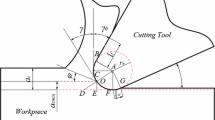Abstract
The temperature and stress fields in beryllium during high speed cutting process were studied by employing a thermo-mechanically coupled finite element method (FEM). The results show that the temperatures in beryllium increase only a little during the cutting process. Both of the residual stresses for along and normal to the cutting direction are tensile stresses in the surface of beryllium after cutting. The cutting force and thrust force are about 280 and −250 kN/m at the steady stage, respectively. The main effects of coolant on the cutting process are to decrease the friction coefficient and heat between the tool and the workpiece, so to reduce the temperature, but almost no effects are made for stress. This study is helpful to enhance the understanding for stress formation and optimize the process parameters of beryllium.
Similar content being viewed by others
References
Dong Ping, Chen Yu-ze, Zou Jue-sheng. Numerical simulation on laser beam welding of beryllium ring [J]. Acta Metallurgica Sinica, 2002, 38(8): 881–884 (in Chinese).
Dong Ping, Li Rui-wen. Stress distribution near crack tip for beryllium specimen under compact tension [J]. Rare Metal Materials and Engineering, 2007, 36(8): 1322–1325 (in Chinese).
Dong Ping, Chen Yu-ze, Zou Jue-sheng. Effect of preheating on temperature and stress fields of laser brazing fusion welding [J]. Transactions of the China Welding Institution, 2004, 25(3): 79–81 (in Chinese).
Zhang Peng-cheng, Dong Ping, Zou Jue-sheng. Study of machining stress along depth in beryllium [J]. Mineral & Metallurgy, 2001, 10(1): 59–62 (in Chinese).
Zhang Peng-cheng, Zou Jue-sheng, Dong Ping. Study of machining stress along depth in beryllium [J]. Nonferrous Metal, 2001, 53(1): 60–63 (in Chinese).
Pantale O, Bacaria J L, Dalverny O. 2D and 3D numerical models of metal cutting with damage effects [J]. Computer Methods in Applied Mechanics and Engineering, 2004, 193: 4383–4399.
Mamalis A G, Horvath M, Branis A S. Finite element simulation of chip formation in orthogonal metal cutting [J]. Journal of Materials Processing Technology, 2001, 110: 19–27.
Deng Wen-jue, Xia Wei. Finite element analysis of orthogonal machining high strength wear-resisting aluminum bronze [J]. Chinese Journal of Mechanical Engineering, 2004, 40(3): 71–75 (in Chinese).
Zhou Ze-hua. Thoery of metal cutting [M]. Beijing: Mechanical Industry Press, 1992.
Author information
Authors and Affiliations
Corresponding author
Additional information
Foundation item: the China Academy of Engineering Physics Funding (No. JM2009-2)
Rights and permissions
About this article
Cite this article
Dong, P., Zhang, Pc. & Li, Rw. Numerical simulation on temperature and stress fields in beryllium during cutting process. J. Shanghai Jiaotong Univ. (Sci.) 16, 329–332 (2011). https://doi.org/10.1007/s12204-011-1154-z
Received:
Published:
Issue Date:
DOI: https://doi.org/10.1007/s12204-011-1154-z




